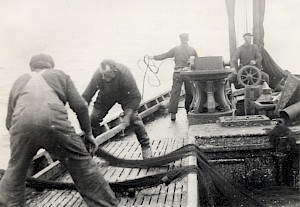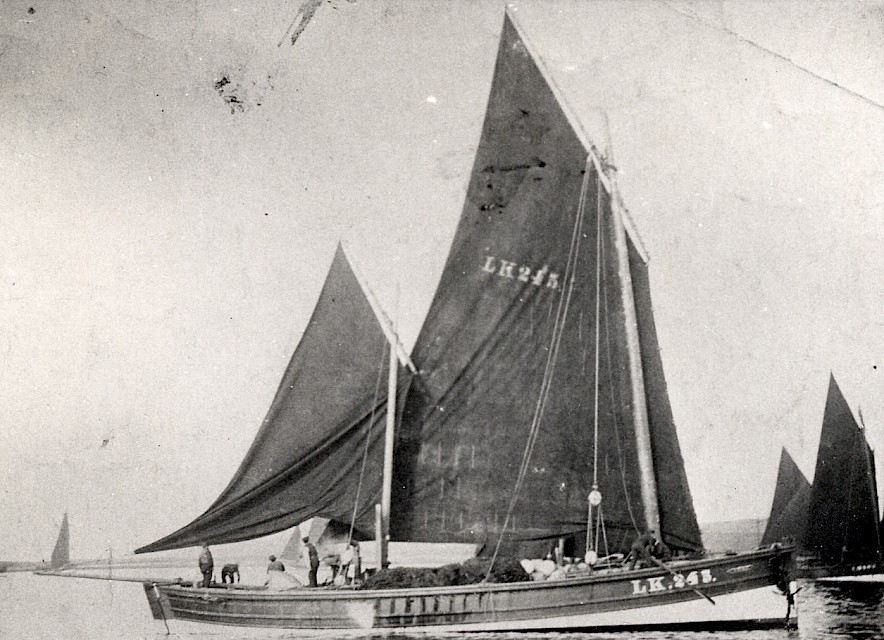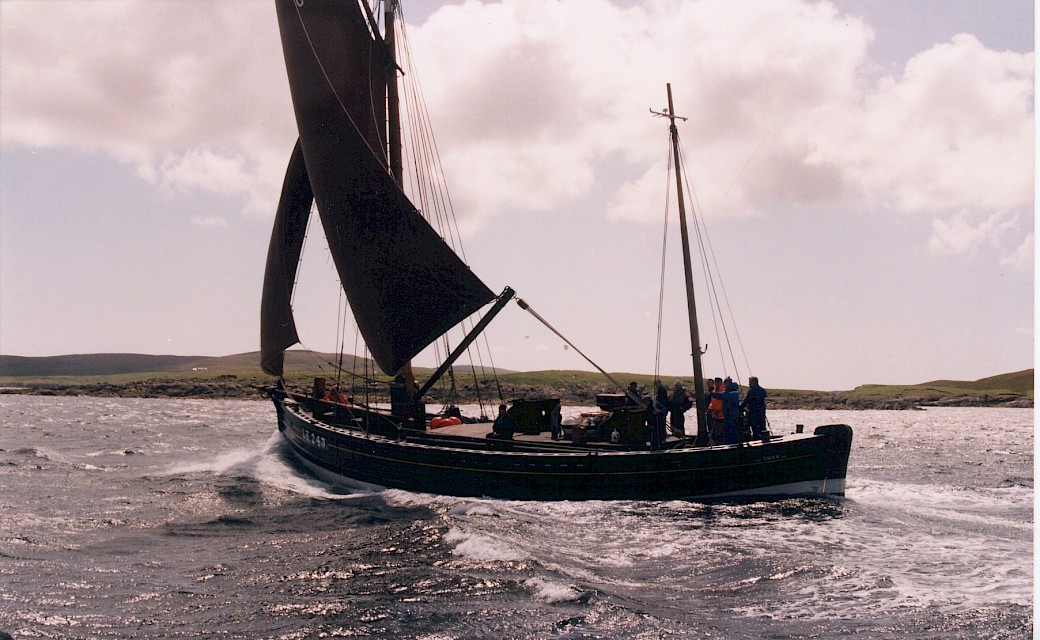Want to get involved in maintaining and operating a traditional wooden sailing vessel? There are a number of different ways you can volunteer to safeguard, care for and sail this unique heritage asset.
Learn more27 February 2021
Joseph Kay has spent the majority of his career as a fisherman, laterally as the second skipper on the Donvale. Now working on the Whalsay Ferry, he continues to be an avid supporter of the fishing industry. Here he shares some of his memories of the Swan, his time at the fishing, and stories from those who crewed the Swan, and similar vessels, in the days of sailing herring drifters.

In Shetland we have much to count our blessings for! Our location may be to our disadvantage regarding travel and freight, but as we have seen during the recent pandemic there are definite advantages in living where we do. In spite of the havoc wrought on the fishing industry, those who remain are enjoying earnings previously unimaginable or undreamt of, and those who were displaced from the fishing industry have mainly found work in the oil and aquaculture industries.
However, there are some who are suffering as a result of the Covid crisis. Hotels, bars, and all involved in the hospitality and travel industries are among those affected, including the Swan which has been tied up over the past year.
Leisure and recreation has been well supported in Shetland from the early days of the oil era, everything from "field and track" to "fiddle and accordion" Such activities are enjoyed by many, young and old, not only by Shetlanders but also visitors from far and wide.
The restoration and running of the Swan has been a big commitment and great achievement for Shetland. At the time of her restoration, there was divided opinion, as with most other things or projects. In spite of that, it was seen through to fruition and she is now a great Shetland ambassador and sail training vessel.
There are those whose role in all this has been admirable, who apart from supporting in spirit, were prepared to roll up their sleeves, get hands dirty and give freely of their own time. Without such selfless support the Swan could not have been rebuilt and kept up. Also, the professional people who were employed in reconstructing, hull, rig and operating the vessel. And of course, all the contributors financially, companies and individuals who have contributed both here and outwith the islands - many with no actual interest but realise the Swan's value in education and recreation.
Anyone who has spent time on the Swan will note that no group enjoys being aboard more than children. Watching a documentary on the restoration of the Cutty Sark after the fire, one of the organisers said of all the donations which poured in to assist this restoration he found the most touching were from young children who had visited the ship some, were sending their pocket money, an example of the impression this left them with. Being at sea is such a different experience for the children, wind in the sails, the motion in a seaway and the voyage, sometimes to foreign destinations. Great credit must go to the patient teachers and crew who accompany them, and what better representation of Shetland in a foreign port than those enthusiastic young people, who often have gifted musicians in their midst, and in some cases there are those doubly gifted in the crew as both first rate sailors and musicians, Maggie Adamson being a prime example.
The Sailing drifters
Having been involved in the Swan project, I should say in small part, and as someone with an interest in maritime and fishing history, it was suggested I comment on her history. The Swan tells the story of the changes which took place in Shetland and in many fishing communities throughout the UK, during the first half of the 20th Century.
JR. Nicholson gives the history of "The Swan" in his book of that name. It gives an insight into the changes which took place on Whalsay from the Zulus and the Fifies to the replacement purpose built diesel powered seiner-drifter's of the 1950s. The following few notes have been recorded or handed down and may add a little more to the Swan's history.
Built in 1900 as a sailing lugger for Thomas Isbister of Lerwick, she was reported in the press at the time to be one of the finest boats in the Scottish fleet. However, when sold to Whalsay in 1905, her hull and rig already belonged to the past, with modern Steam drifters being built and operating successfully. In spite of the modern advances, no steam drifters were ever built for Whalsay. Sailing vessels such as the Swan offered a better opportunity for the fishermen who were to own and operate such sail-drifters. Previously those fishermen were faced with making a living at the haaf fishing in small open boats, crewing on whalers or taking part in the Faroe fishing, all of which was precarious with considerable loss of life. The larger decked herring boats proved a far safer form of fishing than anything that had gone before, the half-deckers and lang-boomers preceded the "Swan type" in Shetland and it was probably on the strength of their success that fishermen were able to purchase the larger decked boats.

During the 1910 herring season the Swan Grossed £455 with the Children's Trust and Research being the only two Whalsay boats bettering her, grossing £570 and £550 respectfully, ref, Shetland Times, 24 Dec 1910. In 1911 the Swan was Whalsay's top boat, with over £500, next were Guide Me and Research with close on £500, ref, Shetland Times 21 October 1911. The Guide Me was one of the afore mentioned "Lang Boomers" only 57 ft and would have probably been carrying fewer nets than either Research or Swan. By 1913 Whalsay had a fleet of 12 large herring boats, that summer season the Swan grossed £711, and was said to be Whalsay's top boat, ref, JR. Nicholson. The earnings at Peterhead that year for sail-boats was £350 to £1,000, with Steam drifters approximately doubling this figure ref, Aberdeen daily journal 15 Sept 1913. While those earnings seem small today, this got the crofter/fishing folk of Whalsay off the ground, from the earthen floor and thatched roof to more comfortable circumstance.
1937 saw Shetland's last operational sailing drifter in the Gracie Brown, by then the old sailing drifters had been scrapped or motorised. It is an interesting fact that those old motorised sail drifters were to see off the steam drifter, the last such converted sail boat being the Research II clued up in the late 1960s. It is also an interesting fact that in spite of Whalsay retaining a large foothold in the present herring or Pelagic fisheries no steam drifter was ever owned in Whalsay.
Fishing Memories
Being at the fishing with several men who were on the Swan in her motorised fishing days, I heard many stories from that time. No fortunes were made at the fishing back then, but such boats kept going and served to keep a thread of fishermen employed, and when the door of opportunity was opened during the 1950s such fishermen were able to take advantage of the Government loan and grant scheme and order new purpose built boats. Those young men in fishing communities such as Whalsay and Burra Isle were the nucleus of our modern fishing industry.
The Swan under her Whalsay ownership, spent her last few winters at the Seine-net, and many nights were spent at moorings in Burravoe, Yell. Leaving Burravoe with a SE gale, Bobby o' Huxter (Bobby Polson snr) was skipper on that occasion, when to weather of Linna-holm the engine stopped, the engineer/driver Davie Kay was in the wheelhouse with Bobby, and said 'I bet that's the points! this magneto seems to be burning them, there are spare ones doon forrad I will go n pit dem in, soodnoo taak lang!' Bobby replied in his characteristic unruffled manner, 'yes do daat, taak dye time, dunoo slip ony o' yun peerie screws ida bilges, it will taak a start afore we drive ashore in Linna-holm'. Bobby normally skippered the Reseach where they had the luxury of two engines, more dependable, if only by the fact that at least one would be expected to keep going.
Mention of Bobby o' Huxter brings another story to mind. After the Swan's restoration she made a trial trip to Whalsay one fine Sunday with a perfect sunny sailing breeze, among the men who took a run from Symbister was Mackie Polson, skipper of the Serene and Bobby's son, he relayed a story told by his father, of the first Research - a Fifie similar to the Swan. They had been out from the Ramna Stacks and were faced with having to tack for Yell-sound with a light contrary wind. Bobby and one of the crew had been left in charge, both teenagers, the remaining crew turned in. On approaching the stacks they stood on as near as they dared before tacking, however in so doing she mistayed only managing to come to the wind before losing headway, with sail's in irons. Before they could do anything she began making stern board, and in an instant the rudder brought her up on the rock, but luckily she fell off on the right tack and saved the situation. None of the crew below were aware of any of this and if any heard anything they probably just thought it was the normal commotion in coming about, this incident was kept secret by Bobby and his watch mate for many years after the event. Mackie was in his element that afternoon and told many other stories, he also crewed on the Swan on occasion.

Working under sail alone in such craft required a thorough knowledge of the shoreline, when faced with tacking through the many sounds around Shetland, they had to take advantage of all navigable water, one occasion when the Swan was making her way from the herring south Whalsay sound under sail, skipper John Simpson and his Brother Robbie were on deck when they spied a local man Thomas Henderson at the craigs at the head of Brough, one said to the other 'haad her up for daa heed I will geen n string up a half o' dozen o' herring n fire ti him', this they did as they made their way south the sound.
The Swan also met with accident one June morning making for Yell-sound:
'The Swan had hauled her nets and was running for port, (North Roe) when her foremast snapped right off. . . Fortunately no one was injured. . .The Swan managed to run in under her own canvas to the entrance to the harbour, when she got assistance from the boat Dauntless. . .There a jury mast was rigged up and the Swan left for Lerwick for repairs. . . Between Whalsay and Lerwick the Swan got assistance from the boat Research of Whalsay' ref, Shetland Times 27 June 1908.
In Whalsay, boats such as Swan were remembered as working fishing boats, converted sail-boats, which were far from ideal for their new roles as motorised seiner-drifters. Many men who manned such boats knew too well the discomfort and awkwardness of working them and believed they had hung on to the past too long, simply because real opportunity did not present itself until the 1950's. My father (Davie Kay) told of the difference from starting the old 75 paraffin Gardner on a cold morning where the first step was to light up two paraffin blowlamps to warm the engine then came the physically demanding job of turning it over by hand until it started, where on the modern replacement boat, it took only the push of a button, to start the modern Gardner diesel. He also told of joining the Swan as cook and coiler, where as were most in that chamber of horrors the "rope hole" he was bothered with sea-sickness. This not being misery enough, many of the old hands smoked black twist tobacco in a pipe, the rope hole was maybe handy with the steam boiler, anyhow matches were kept in there and the boy-coiler's secondary role was that of lighting up those pipes in turn that frequently were extinguished on deck.
However, few on Whalsay or anywhere else would disagree in wishing the Swan and all who sail in her all the best, and hope she finds her way back to sea as soon as possible.
Follow these links to donate or volunteer with the Trust.
Anyone can sail on Swan, for details of trips available to book check out our upcoming trips
Links to other personal stories of Swan:

Swan during her fishing days

Swan sailing following her relaunch as a sail training vessel in the 1990s

Swan with her original lugger rig - dates this to 1900-1908, when she was changed to smack rig

Swan in the 1990s, following her relaunch

The caption to the photograph above refers to Sail Boats, the 1930's were poor years for the herring fishing in general, by 1935 Whalsay was left with just 7 large herring boats, a reduction from 30 at its peak.

Fishermen 'shooting fast' on a fife in the 1920s
Want to get involved in maintaining and operating a traditional wooden sailing vessel? There are a number of different ways you can volunteer to safeguard, care for and sail this unique heritage asset.
Learn morePupils and teachers from Sound Primary School, in Lerwick, recently enjoyed half day sailing trips on Swan - gaining experience in sailing the boat and learning about Shetland's maritime heritage.
Read MoreIconic local boat Swan is set to benefit from a major internal upgrade this winter, following the confirmation of a funding package from local and national sources, and the appointment of a local firm to carry out the work.
Read More